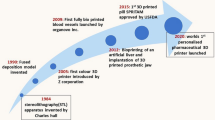Abstract
This study combined rotational 3D printing with femtosecond laser postprocessing to produce a biodegradable polylactic acid (PLA) prototype stent suitable for treating peripheral arterial diseases. First, the peripheral arterial stent structure was designed with the assist of the finite element method. The external diameter of the stent was compressed from 4 to 2 mm for placement in the catheter, and balloon dilation was performed to expand the outer diameter to 5.4 mm. Subsequently, rotational 3D printing was conducted in conjunction with a femtosecond laser to produce and postprocess the designed stent structure. A PLA stent with uniform structural widths, smooth edges, and accurate structural dimensions was successfully produced. The strut width, connector width, and crown radius of the PLA stent were respectively 0.205 mm (standard deviation [SD] = 0.005 mm), 0.203 mm (SD = 0.004 mm), and 0.303 mm (SD = 0.003 mm). Finally, the stent was compressed and expanded to measure its radial force performance after expansion. The fabricated stent achieved the required radial force of 0.079 N/mm and met the required specifications for a peripheral arterial stent.

















Similar content being viewed by others
References
Criqui MH, Aboyans V (2015) Epidemiology of peripheral artery disease. Circ. Res. 116(9):1509–1526
Sherif M (2018) Angioplasty and stenting for peripheral arterial disease of the lower limbs. e-Journal of Cardiology Practice:16(8)
Wressnegger A, Kaider A, Funovics MA (2017) Self- expanding nitinol stents of high versus low chronic out- ward force in de novo femoropopliteal occlusive arterial lesions (BIOFLEX-COF trial): study protocol for a randomized controlled trial. Trials. 18:594–594
Galyfos G, Geropapas G, Stefanidis I, Kerasidis S, Stamatatos I, Kastrisios G, Giannakakis S, Papachar-alampous G, Maltezos C (2015) Bioabsorbable stenting in peripheral artery disease. Cardiovasc Revasc Med 16(8):480–483
Haelst STW, SMOP W, Borst GJ, Moll FL (2016) Current status and future perspectives of bioresorbable stents in peripheral arterial disease. J. Vasc. Surg. 64(4):1151–1159
Chu TM, Chan YC, Cheng SW (2017) Evidence for treating peripheral arterial diseases with biodegradable scaffolds. J Cardiovasc Surg (Torino) 58(1):87–94
van Haelst ST, Peeters Weem SM, Moll FL, de Borst GJ (2016) Current status and future perspectives of bioresorbable stents in peripheral arterial disease. J Vasc Surg 64(4):1151–1159
Zhu Y, Yang K, Cheng R, Xiang Y, Yuan T, Cheng Y, Sarmento B, Cui W (2017) The current status of biodegradable stent to treat benign luminal disease. Mater. Today 20(9):516–529
Guerra A, de Ciurana J (2017) Fibre laser cutting of polymer tubes for stents manufacturing. Procedia Manuf. 13:190–196
Guerra A, Roca A, de Ciurana J (2017) A novel 3D additive manufacturing machine to biodegradable stents. Procedia Manuf. 13:718–723
Letcher T, Waytashek M (2014) Material property testing of 3D-printed specimen in PLA on an entry-level 3D printer. presented at the ASME International Mechanical Engineering Congress and Exposition, Proceedings (IMECE)
Grasso M, Azzouz L, Ruiz-Hincapie P, Zarrelli M, Ren G (2018) Effect of temperature on the mechanical properties of 3D-printed PLA tensile specimens. Rapid Prototyp J 24(8):1337–1346
Rizvi N (2003) Femtosecond laser micromachining: current status and applications. RIKEN Rev 50:107–112
Hendricks F, Patel R, Matylitsky VV (2015) Micromachining of bio-absorbable stents with ultra-short pulse lasers. Proc. SPIE 9355, Frontiers in Ultrafast Optics: Biomedical, Scientific, and Industrial Applications XV935502
Schiavone A, Zhao LG (2015) A study of balloon type, system constraint and artery constitutive model used in finite element simulation of stent deployment. Mechanics of Advanced Materials and Modern Processes 1(1):1
Zhao D, Zhou R, Sun J, Li H, Jin Y (2019) Experimental study of polymeric stent fabrication using homemade 3D printing system. Polym. Eng. Sci. 59:1122–1131
Hung CH, Chang FY, Chang TL, Chang YT, Huang KW, Liang PC (2015) Micromachining NiTi tubes for use in medical devices by using a femtosecond laser. Opt Lasers Eng 66:34–40
Kao CL (2017) Development of 5-French nitinol biliary stents. Master Thesis, National Taiwan University of Science and Technology
Wu TJ (2020) Post-process of 3D printed stent by femtosecond laser. Master Thesis, National Taiwan University of Science and Technology
Nakra BC, Chaudhry KK (2016) Instrumentation measurement and Analysis 4th edition. Hill, McGraw
Hung CH, Chang FY (2017) Curve micromachining on the edges of nitinol biliary stent by ultrashort pulses laser. Opt Laser Technol 90:1–6
Ang HY, Huang YY, Lim ST, Wong P, Joner M, Foin N (2017) Mechanical behavior of polymer-based vs. metallic-based bioresorbable stents. J. Thorac. Dis. 9(9):S923–S934
Peters B, Ewert P, Berger F (2009) The role of stents in the treatment of congenital heart disease: current status and future perspectives. Ann Pediatr Cardiol 2(1):3–23
Wu BHP (2007) Method of crimping a polymeric stent. US Patent US20070271763A1
Kumar A, Ahuja R, Bhati P, Vashisth P, Bhatnagar N (2019) Design Methodology of a balloon expandable polymeric stent. Journal of Biomedical Engineering and Medical Devices 4(2).
Brandt-Wunderlich C, Schmidt W, Grabow N, Stiehm M, Siewert S, Andresen R, Klaus-Peter S (2019) Support function of self-expanding nitinol stents – are radial resistive force and crush resistance comparable? Curr. Dir. Biomed. Eng. 5(1):465–467
Funding
This research was supported by Ministry of Science and Technology, Taiwan, Republic of China under grant MOST 106-2221-E-011-071-MY2 and MOST 108-2221-E-011-128.
Author information
Authors and Affiliations
Contributions
Fuh-Yu Chang planned and executed the study, and wrote the paper. Te-Hsien Liang performed the simulation work and data analysis. Tsung-Jung Wu performed the 3D printing and femtosecond laser machining work. Chien-Hsing Wu performed the femtosecond laser work.
Corresponding author
Ethics declarations
Conflict of interest
The authors declare no competing interest.
Additional information
Publisher’s note
Springer Nature remains neutral with regard to jurisdictional claims in published maps and institutional affiliations.
Rights and permissions
About this article
Cite this article
Chang, FY., Liang, TH., Wu, TJ. et al. Using 3D printing and femtosecond laser micromachining to fabricate biodegradable peripheral vascular stents with high structural uniformity and dimensional precision. Int J Adv Manuf Technol 116, 1523–1536 (2021). https://doi.org/10.1007/s00170-021-07446-z
Received:
Accepted:
Published:
Issue Date:
DOI: https://doi.org/10.1007/s00170-021-07446-z




